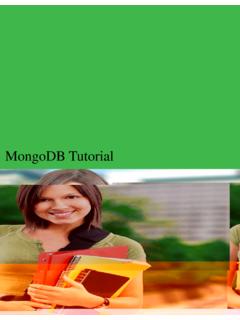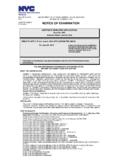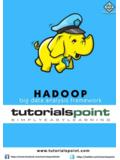Transcription of Chapter1
1 Chapter 1 About This Book1 LicenseThe Little mongodb Book book is licensed under the Attribution-NonCommercial Unported should nothave paid for this are basically free to copy, distribute, modify or display the book. However, I ask that you always attribute thebook to me, Karl Seguin and do not use it for commercial can see the full text of the license at: The AuthorKarl Seguin is a developer with experience across various fields and technologies. He s an expert .NET and Rubydeveloper. He s a semi-active contributor to OSS projects, a technical writer and an occasional speaker. With respectto mongodb , he was a core contributor to the C# mongodb library NoRM, wrote the interactive tutorialmonglyas wellas theMongo Web Admin. His free service for casual game developers, , is powered by has since writtenThe Little Redis BookHis blog can be found , and he tweets via Thanks ToA special thanks toPerry Nealfor lending me his eyes, mind and passion. You provided me with invaluable help.
2 VersionThis version was updated for mongodb by Asya Kamsky. The latest source of this book is available at: 2 IntroductionIt s not my fault the chapters are short, mongodb is just easy to is often said that technology moves at a blazing pace. It s true that there is an ever growing list of new technologiesand techniques being released. However, I ve long been of the opinion that the fundamental technologies used byprogrammers move at a rather slow pace. One could spend years learning little yet remain relevant. What is strikingthough is the speed at which established technologies get replaced. Seemingly overnight, long-established technologiesfind themselves threatened by shifts in developer could be more representative of this sudden shift than the progress of NoSQL technologies against well-established relational databases. It almost seems like one day the web was being driven by a few RDBMSs, and thenext, five or so NoSQL solutions had established themselves as worthy though these transitions seem to happen overnight, the reality is that they can take years to become acceptedpractice.
3 The initial enthusiasm is driven by a relatively small set of developers and companies. Solutions are refined,lessons learned and seeing that a new technology is here to stay, others slowly try it for themselves. Again, this isparticularly true in the case of NoSQL where many solutions aren t replacements for more traditional storage solutions,but rather address a specific need in addition to what one might get from traditional said all of that, the first thing we ought to do is explain what is meant by NoSQL. It s a broad term thatmeans different things to different people. Personally, I use it very broadly to mean a system that plays a part in thestorage of data. Put another way, NoSQL (again, for me), is the belief that your persistence layer isn t necessarily theresponsibility of a single system. Where relational database vendors have historically tried to position their softwareas a one-size-fits-all solution, NoSQL leans towards smaller units of responsibility where the best tool for a given jobcan be leveraged.
4 So, your NoSQL stack might still leverage a relational database, say MySQL, but it ll also containRedis as a persistence lookup for specific parts of the system as well as Hadoop for your intensive data processing. Putsimply, NoSQL is about being open and aware of alternative, existing and additional patterns and tools for managingyour might be wondering where mongodb fits into all of this. As a document-oriented database, mongodb is a moregeneralized NoSQL solution. It should be viewed as an alternative to relational databases. Like relational databases, ittoo can benefit from being paired with some of the more specialized NoSQL solutions. mongodb has advantages and7drawbacks, which we ll cover in later parts of this 3 Getting StartedMost of this book will focus on core mongodb functionality. We ll therefore rely on the mongodb shell. While the shellis useful to learn as well as being a useful administrative tool, your code will use a mongodb does bring up the first thing you should know about mongodb : its drivers.
5 mongodb has anumber of official driversfor various languages. These drivers can be thought of as the various database drivers you are probably already familiarwith. On top of these drivers, the development community has built more language/framework-specific libraries. Forexample,NoRMis a C# library which implements LINQ, andMongoMapperis a Ruby library which is ActiveRecord-friendly. Whether you choose to program directly against the core mongodb drivers or some higher-level library isup to you. I point this out only because many people new to mongodb are confused as to why there are both officialdrivers and community libraries - the former generally focuses on core communication/connectivity with mongodb andthe latter with more language and framework-specific you read through this, I encourage you to play with mongodb to replicate what I demonstrate as well as to explorequestions that you might come up with on your own. It s easy to get up and running with mongodb , so let s take a fewminutes now to set things over to theofficial download pageand grab the binaries from the first row (the recommended stable version)for your operating system of choice.
6 For development purposes, you can pick either 32-bit or the archive (wherever you want) and navigate to thebinsubfolder. Don t execute anything just yet,but know thatmongodis the server process andmongois the client shell - these are the two executables we ll bespending most of our time a new text file in thebinsubfolder :dbpath=PATH_TO_WHERE_YOU_WANT_TO_STORE_ YOUR_DATABASE_FILES. For example, on Windows you might dodbpath=c:\ mongodb \dataand on Linux you might dodbpath=/var/lib/ sure thedbpathyou specified mongod with the--config/path/to/ an example for Windows users, if you extracted the downloaded file toc:\ mongodb \and you createdc:\ mongodb \data\then withinc:\ mongodb \bin\ would specifydbpath=c:\ mongodb \data\. You could thenlaunchmongodfrom a command prompt viac:\ mongodb \bin\mongod--configc:\mongo db\bin\ free to add thebinfolder to your path to make all of this less verbose. MacOSX and Linux users can follow almostidentical directions. The only thing you should have to change are the you now have mongodb up and running.
7 If you get an error, read the output carefully - the server is quitegood at explaining what s can now launchmongo(without thed) which will connect a shell to your running server. Try ()to make sure everything s working as it should. Hopefully you ll see the version number you 4 Chapter 1 - The BasicsWe begin our journey by getting to know the basic mechanics of working with mongodb . Obviously this is core tounderstanding mongodb , but it should also help us answer higher-level questions about where mongodb get started, there are six simple concepts we need to has the same concept of adatabasewith which you are likely already familiar (or a schema for youOracle folks). Within a mongodb instance you can have zero or more databases, each acting as high-levelcontainers for everything database can have zero or morecollections. A collection shares enough in common with a traditionaltablethat you can safely think of the two as the same are made up of zero or moredocuments.
8 Again, a document can safely be thought of as document is made up of one or morefields, which you can probably guess are a lot mongodb function mostly like their RDBMS different than the other five concepts but they are important enough, and often overlooked, thatI think they are worthy of their own discussion. The important thing to understand about cursors is that whenyou ask mongodb for data, it returns a pointer to the result set called a cursor, which we can do things to, suchas counting or skipping ahead, before actually pulling down recap, mongodb is made up ofdatabaseswhich containcollections. Acollectionis made up made up beindexed, which improves lookup and sorting , when we get data from mongodb we do so through acursorwhose actual execution is delayed until use new terminology (collection vs. table, document vs. row and field vs. column)? Is it just to make things morecomplicated? The truth is that while these concepts are similar to their relational database counterparts, they are notidentical.
9 The core difference comes from the fact that relational databases definecolumnsat thetablelevel whereasa document-oriented database defines itsfieldsat thedocumentlevel. That is to say that eachdocumentwithin acollectioncan have its own unique set offields. As such, acollectionis a dumbed down container in comparisonto atable, while adocumenthas a lot more information than this is important to understand, don t worry if things aren t yet clear. It won t take more than a couple ofinserts to see what this truly means. Ultimately, the point is that a collection isn t strict about what goes in it (it sschema-less). Fields are tracked with each individual document. The benefits and drawbacks of this will be exploredin a future s get hands-on. If you don t have it running already, go ahead and start themongodserver as well as a mongoshell. The shell runs JavaScript. There are some global commands you can execute, likehelporexit. Commandsthat you execute against the current database are executed against thedbobject, such () ().
10 Commands that you execute against a specific collection, which is what we ll be doing a lot of, are executed , such () ().Go ahead and (), you ll get a list of commands that you can execute against small side note: Because this is a JavaScript shell, if you execute a method and omit the parentheses(), you llsee the method body rather than executing the method. I only mention it so that the first time you do it and get aresponse that starts withfunction(..){you won t be surprised. For example, if you (without theparentheses), you ll see the internal implementation of we ll use the globalusehelper to switch databases, so go ahead and enteruselearn. It doesn t matter that thedatabase doesn t really exist yet. The first collection that we create will also create the actuallearndatabase. Nowthat you are inside a database, you can start issuing database commands, (). If you doso, you should get an empty array ([ ]). Since collections are schema-less, we don t explicitly need to create can simply insert a document into a new collection.}




